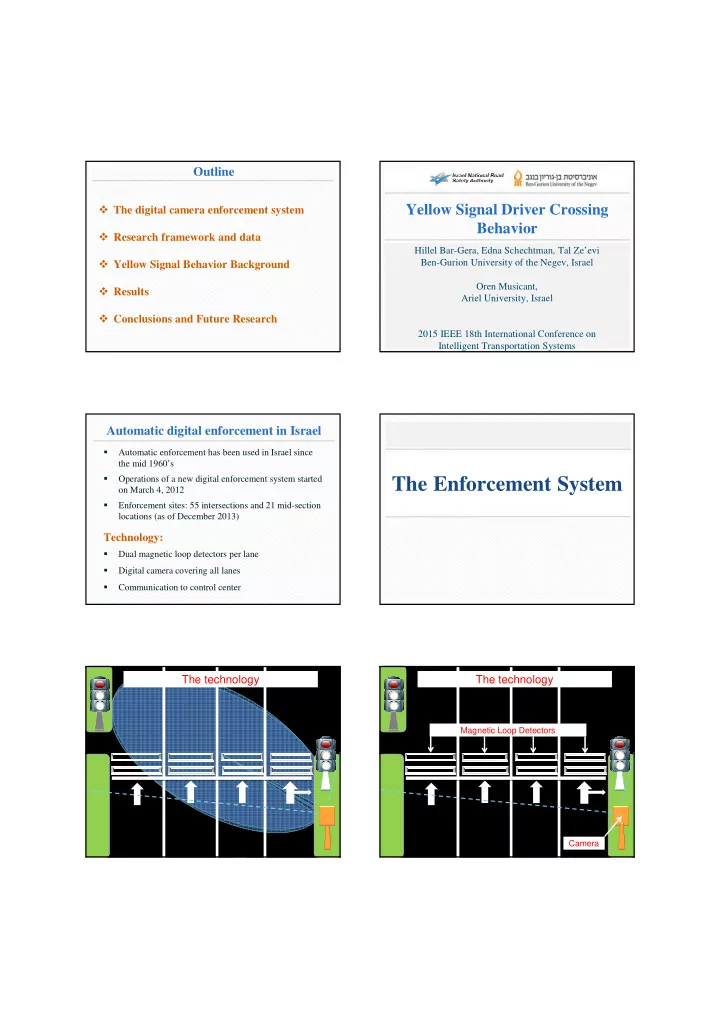

Outline � The digital camera enforcement system Yellow Signal Driver Crossing Behavior � Research framework and data Hillel Bar-Gera, Edna Schechtman, Tal Ze’evi � Yellow Signal Behavior Background Ben-Gurion University of the Negev, Israel Oren Musicant, � Results Ariel University, Israel � Conclusions and Future Research 2015 IEEE 18th International Conference on Intelligent Transportation Systems Automatic digital enforcement in Israel � Automatic enforcement has been used in Israel since the mid 1960’s � Operations of a new digital enforcement system started The Enforcement System on March 4, 2012 � Enforcement sites: 55 intersections and 21 mid-section locations (as of December 2013) Technology: � Dual magnetic loop detectors per lane � Digital camera covering all lanes � Communication to control center The technology The technology Magnetic Loop Detectors Camera
Research Framework Overall Research Goal: to evaluate the effect of digital enforcement cameras on driver behavior and on safety. Research Framework Data Sources: � Point speed measurements (pneumatic) � Point-to-point speed measurements (BlueTooth) � Point-to-point speed measurements (GPS) � Enforcement system data: speeds, yellow crossings, citations. � Public opinion surveys on speed and enforcement � Accident data Scope of data Pneumatic speed measurements: • ~600,000 vehicles at 146 measurement lanes Yellow Signal Behavior: GPS data • ~100,000 vehicles, 42 road sections, 3 years Background ~ 700 million records (record: position, time and speed • of a single vehicle) Enforcement system data ~ 125 million observations at 21 speed cameras • ~ 285 million observations at 55 traffic signal cameras • Public opinions surveys at gas stations • 4 annual surveys at 9 gas stations, ~60 respondents per station. ~2,000 total respondents. Safety Implications of Definition of Yellow Onset States Traffic Signal Behavior (common perspective) Can stop safely Cannot stop � safely In 2012, 683 people were killed and an estimated 133,000 were injured in accidents that involved red Can cross before Multiple-options Should-cross light running in the US [IIHS, 2015]. red (#4) (#2) Cannot cross Should-stop No-safe-option � During 2004-2009 in West Australia 20% of serious before red (#1) (#3) casualty accidents at signalized intersections were rear- end, compared with only 4% at sign-controlled � Following Gazis, Herman Maradudin (1960). intersections [Devlin et al, 2011]. � “Can Cross” - assuming constant speed. � “Can Stop” - assuming “maximal” deceleration. � Variations in driver behavior are ignored.
Crossing Probability Terminologies in Yellow Behavior Studies and the Extrapolated Entrance Time Proposed Extrapolated Yellow behavior Multiple- No-safe- taxonomy Entrance Time uncertainty options option (EET) situation situation Definitions: Liu et al. (1996) [8] Yellow interval � D ys – Distance at yellow onset dilemma � S ys – Speed at yellow onset Köll et al. (2004) Potential time Option zone Dilemma zone [6] � EET = D ys / S ys Extrapolated Entrance Time Gates et al. (2007) Estimated travel Dilemma zone / Dilemma zone Dilemma zone � AET – Actual Entrance Time [4] time Indecision zone Rakha et al. (2007) Time to Dilemma zone [9] intersection (TTI) EET is a key factor for predicting the probability that a Papaioannou, Option zone Dilemma zone (2007) [10] vehicle will cross the intersection at the end of the green Hurwitz et al. Time to stop bar Dilemma zone Dilemma zone Dilemma zone light (Haque et al., 2013; Gates et al., 2007). (2011) [11] type II type II type I Haque et al. (2013) Time to stop line [12] (TSL) Bar-Gera et al. Amber Onset Time Indecision zone (2013) [5] (AOT) Existing Data Collection Methodologies Study type: Results � Lab-type experiments: driving simulators, special purpose tracks. (e.g. Rakha et al., 2007; Haque et al., 2013; Bar-Gera et al. 2013; ) � Video measurements at real intersections. (e.g. Köll et al., 2004; Gates et al., 2007; Papaioannou, 2007) Limitations: � Sample sizes are limited. Typically, up to 2000 yellow crossing events. Entrance Time Distribution Yellow and Red Crossing Proportions After Yellow Onset
Entrance Time Distribution: Entrance Time Distribution: Early Yellow Frequencies are Nearly Stable Nearly Stable Early Yellow Frequencies are Unstable Unstable (0< ∆ BIC<10, n=13) (10< ∆ BIC, n=6) Entrance Time Distribution: 4 Parameters Logistic - Early Yellow Frequencies are Stable Stable ( ∆ BIC<0, n=18) Yellow Phase Red Phase t Exponential Logistic vs. 4PL Comparison Logistic Regression - Yellow Phase Red Phase t
Key Characteristics - Definitions Key Characteristics of All Intersections τ 0.9 τ 0.5 τ 0.1 τ 0.1-0.9 Entrance Time After the Yellow Onset [Ms] Key Characteristics Day-To-Night Comparison Conclusions and Future Research Future Research Summary and Conclusions • Examine causes of heterogeneity, within and • Loop detector data can be used to naturalistically between intersections. quantify driver behavior following yellow onset. • Evaluate influence on behavior of changes to • Results are based on ~5 million yellow crossings enforcement, signal timing, etc. (about 2.3% of all 200 million crossings). • Analyze connection to accident records. • Exponential logistic fits the data better than four- parameter logistic. • Add end-of-green frequencies. • The duration of frequency reduction from 90% to • Consider phase duration and cycle time as 10% ranges from 1.9s to 2.9s – substantial variation. explanatory variables. • Night-time and day-time behaviors are usually • Utilize other types of loop detectors (e.g. controller similar. detectors).
Recommend
More recommend